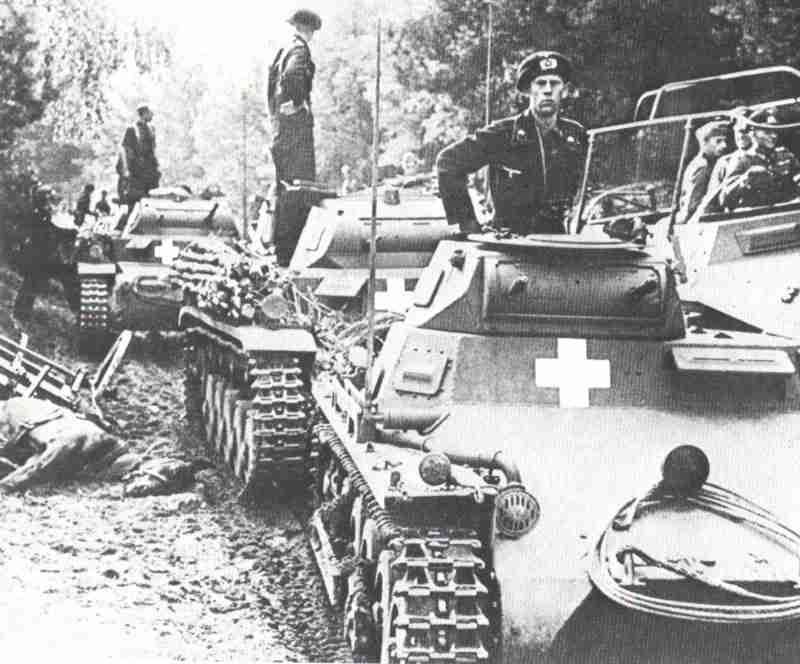Rommel plays with Minatures for D Day
https://www.youtube.com/watch?v=rRuzjs9T_dw&t=29s
On this day during W.W. 2
-
@captainwalker said in On this day during W.W. 2:
13th June 1944: London;
The V1 Flying Bomb, ( Hitler’s Vergeltungswaffe 1, Vengeance Weapon 1) known by The Allies as Buzz Bombs or Doodlebugs was an early cruise missile & the only production aircraft to use pulsejet for power.
The Wehrmacht started launching the V1’s in mid 1944. A total of 9,521 were fired at London & the South East Coast, the first hitting London, next to a railway bridge, on Grove Road, Mile End, on 13th June 1944, killing 8 civilians. The last V1 hit the UK in October 1944, when the sites were overrun by the advancing Allies, after which they targeted Belgium, until 29th March 1945.
Several methods were incorporated to Destroy the V1’s, Anti-aircraft guns & Barrage Balloons being two of them. The Third was the Interceptor, (Fighter Aircraft). Early attempts to Intercept the V1’s often failed, but improved techniques soon emerged. One of these was the use of airflow over the Interceptors Wing to raise one wing of the V1, by sliding the wingtip to within 6 inches (15cm) of the lower surface of the V1’s wing, (as shown in photographs below)
When properly executed, this manoeuvre would tip the V1’s wing up, thereby overriding the gyro & sending the V1 into an out of control dive. At least 16 V1’s were destroyed this way, the first by Major R E Turner, of 356th Fighter Squadron on the 18th June 1944;
The total number of casualties inflicted by the V1’s was 22,892.
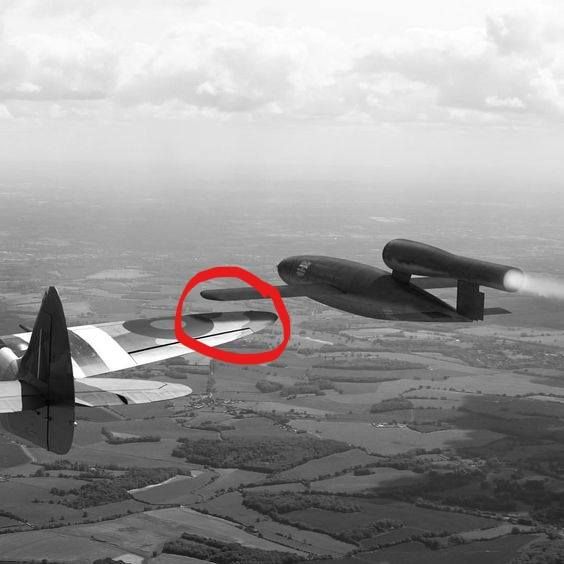
I read about the V-1 but didn’t know it did that much in casualties. I know they were shot down or as u were saying thrown off track and such.
Ya I know in a game where figs can intercept them. -
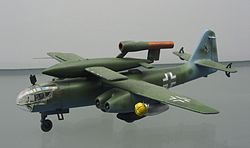 https://en.m.wikipedia.org/wiki/File:Arado_Ar_234_Blitz_mit_V1_pic1.JPG
https://en.m.wikipedia.org/wiki/File:Arado_Ar_234_Blitz_mit_V1_pic1.JPGIt’s funny how a missile was made to look like a plane. Needed the wings for guidance.
Just think if they had that weapon at start of war in 39. Who knows with that they would of had the jump on allies maybe for a couple of years. But that’s a but and the allies may have countered it early too just like they did in 44 45. -
Another thought. Technology wise the Germans invented the Kami attack first. Japan also received the motor for this V-1 rocket/missile/plane in 1943 by German sub and plans were found where the Japs had plans for 3 types of launch mechanizations and 1 of them was from a sub.
This would be a good event card in my game where Japan gets a free attempt at Rockets or something to that effect.9-11 is another example too unfortunately.
-
@SS-GEN said in On this day during W.W. 2:
It’s funny how a missile was made to look like a plane. Needed the wings for guidance.
Just think if they had that weapon at start of war in 39. Who knows with that they would of had the jump on allies maybe for a couple of years. But that’s a but and the allies may have countered it early too just like they did in 44 45.The reason V1 had wings (in contrast with the finned V2) wasn’t really a matter of guidance, it was a matter of how much energy it takes to move a mass of x kilograms over a distance of y kilometers (in this case, from France to London) at a speed of z kilometers per hour. The purpose of the V1’s wings, like those of a conventional aircraft, was to provide lift and thus give the V1 the ability to fly in a conventional manner on a more or less horizontal flight path. The V1, which weighed two tons, could get from point A to point B at 640 kph, on a relatively modest amount of fuel. The V2, by contrast, weighed six times more and travelled nine times faster; it followed a ballistic trajectory rather than a horizontal flight path, which is why it didn’t need wings. The trade-off, however, was a ballistic missile requires much greater thrust than an aircraft, which in turn requires larger quantities of more energetic fuel. Also note that rockets like the V2 need to carry their own fuel oxidizer, whereas air-breathing jet aircraft like the V1 don’t, which is another reason why jets can sustain themselves in flight on a relatively modest fuel load.
The question of whether the V1 and the V2 could have altered the outcome of WWII if they’d been developed, let’s say, about five years earlier is an interesting one; my impression is that, in and of themselves, they would not have done so, even if they’d been deployed in much larger quantities. The V1 and V2 were basically an expensive and inefficient alternate way (in terms of their bang-for-the-buck ratio) of bombing a city with low precision, so in that respect Germany would have been better off developing a proper heavy bomber design and a proper long-range escort fighter and producing both in large quantities. The only unquestioned advantage which the V2 had over any conventional bomber, or the V2, was that it was impossible for the defenders to intercept it once it was launched. Which brings me back to the “in and of themselves” point I mentioned earlier: the V2 by itself was not a weapon which could have changed the outcome of WWII, but if it had been equiped with an atomic warhead it would have been a serious strategic threat to the Allies. But even here, we have to be careful about jumping to conclusions. First, the German atomic program was years behind that of the US – and even the US, which devoted huge resources to the Manhattan Project, only produced (and detonated) three bombs (one was a test device) by the summer of 1945 (by which time Germany had already surrendered). So even if we were to assume (and it’s a big assumption) that Germany could have matched the Manhattan Project, and even done better by assembling its bombs a year earlier than the Americans did, the question becomes: would the Allies have surrendered if, let’s say, London and Moscow had each been nuked in mid-1944 by a V2 with a kiloton-level atomic warhead? The Russians, who’d already lost tens of millions of people and who’d seen huge areas of their countries devastated by conventional warfare, would certainly have kept going, and would probably have been even more determined than before to take their revenge against Nazi Germany. The Americans would also have kept going, with an even greater conviction than before that Nazi Germany was enormously dangerous and had to be stopped by any means possible. And my guess is that even the British would have kept going: they would have known from their intelligence sources that Germany had used up its tiny supply of warheads and they would have known that by that date the momentum of the war was on the Allied side. Furthermore, it’s hard to imagine what the practical details of a British surrender would have looked like in mid-1944, given that up until D-Day Britain was basically the operational base of a gigantic American army which, presumably, would not have meekly gone back home if Churchill – in a completely out-of-character move – would have told Eisenhower, “Thanks, but we don’t need you anymore.”
-
Ha. That line “Hey we don’t need you now” is like any country dreaming. Anyway
Awesome reply and as for guidance ya my thought was in line of lift and such as you mentioned.
My thought on v-1 was mainly for like groups of inf. Supply and fuel depots and some city’s starting in 39. But as u said to early as far as war was and accuracy. -
“we don’t need ya now” lol good one. Reminds of the Tehran conference. i don’t remember the story exactly, but basically it was
After the war the US/UK will leave Persia but whose gonna make the russians leave ? We invaded Iran and split it with Russia, which we think is good. The Germans invaded Poland and split it with Russia, which we think is bad.
So appealing to Stalin’s better nature probably won’t work.Anyway some language was put into the agreement that russia had to leave after the war. Truman had to give’em hell, no pun intended, to get them to leave, but they did.
-
June 18, 1940. Western Front
Rommel’s 7th Panzer Division races 200 miles and reaches Cherbourg. However, they arrive too late to prevent the Allied evacuation and rest overnight before attacking the fortifications. Operation Ariel finishes at St. Nazaire (leaving behind all their equipment on rumours the Germans are poised to take the town) and at La Pallice where 2,303 British are evacuated.
With 5th Panzer Division only a few hours away, French cruisers El Djezair, El Kantara, El Mansour, Ville d’Oran and Ville d’Alger transport 1,200 tons of French gold from Brest. The convoy will arrive in Casablanca on June 21. In addition, the French move 198 tonnes of Belgian gold on the cruiser Victor-Schoelcher from Lorient to the port of Dakar in French West Africa. The gold should have been sent to USA and will ultimately fall into German hands (much to the chagrin of the Belgians who sue the Banque de France in 1941, demanding in return French gold being held in the USA).
British Prime Minister Winston Churchill gives another charismatic speech in the House of Commons, commenting on the likely fall of France “the Battle of France is over” and prospects for a cross-Channel invasion by Germany “I expect that the Battle of Britain is about to begin.” He concludes “Let us therefore brace ourselves to our duties, and so bear ourselves that, if the British Empire and its Commonwealth last for a thousand years, men will still say, ‘This was their finest hour’."
Source: worldwar2daybyday
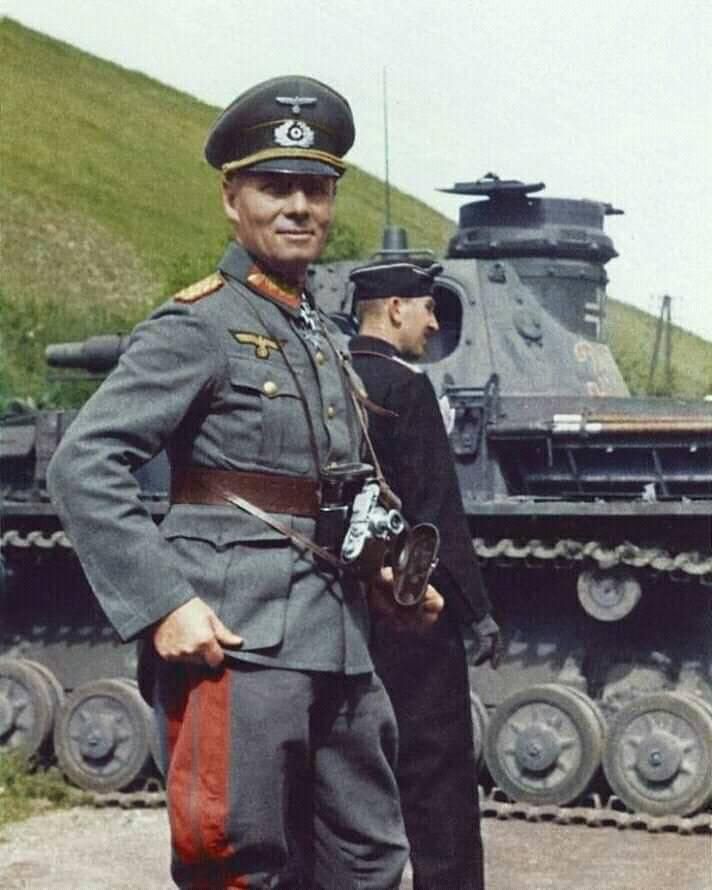
-
August 1, 1943. Operation Tidal Wave
178 B-24 Liberator very long range heavy bombers of the 8th and 9th Air Forces (United States Army Air Forces) based in Libya, with 1,751 crewmen, made an extreme low-level attack on the Axis oil refineries at Ploesti, Romania.
The mission was a disaster: 53 B-24s were lost, 310 crewmen killed in action, 108 captured, and 78 interred in neutral countries. The damaged refineries were repaired within weeks and their output was higher than before the attack.
Five Medals of Honor were awarded, three posthumously, the most for any single air action in history.
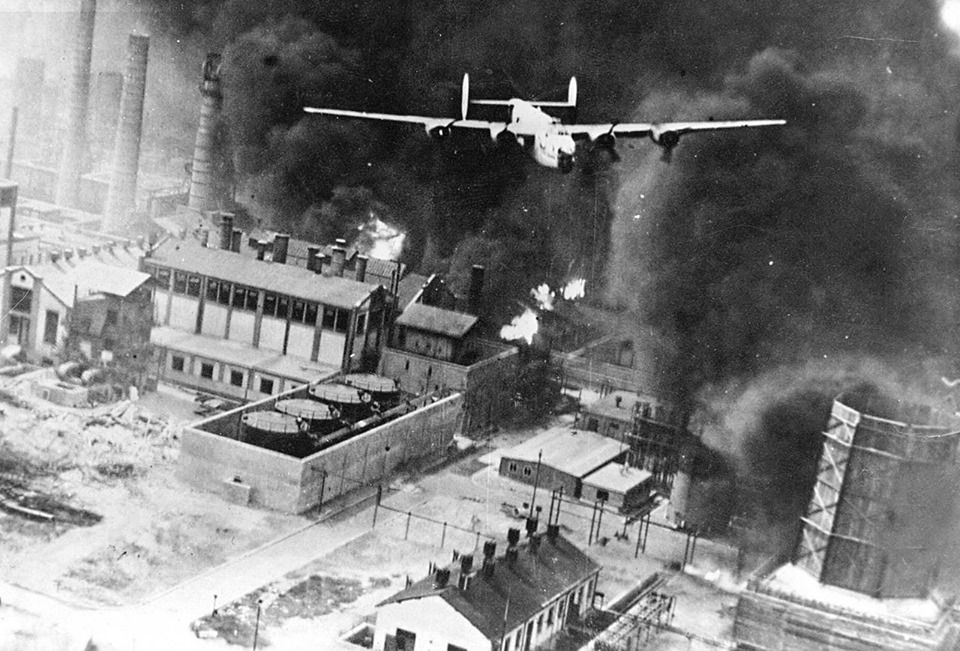
-
One of the most famous images of World War II shows The Sandman, piloted by Robert Sternfels, as it emerges from a pall of smoke during the Operation Tidal Wave
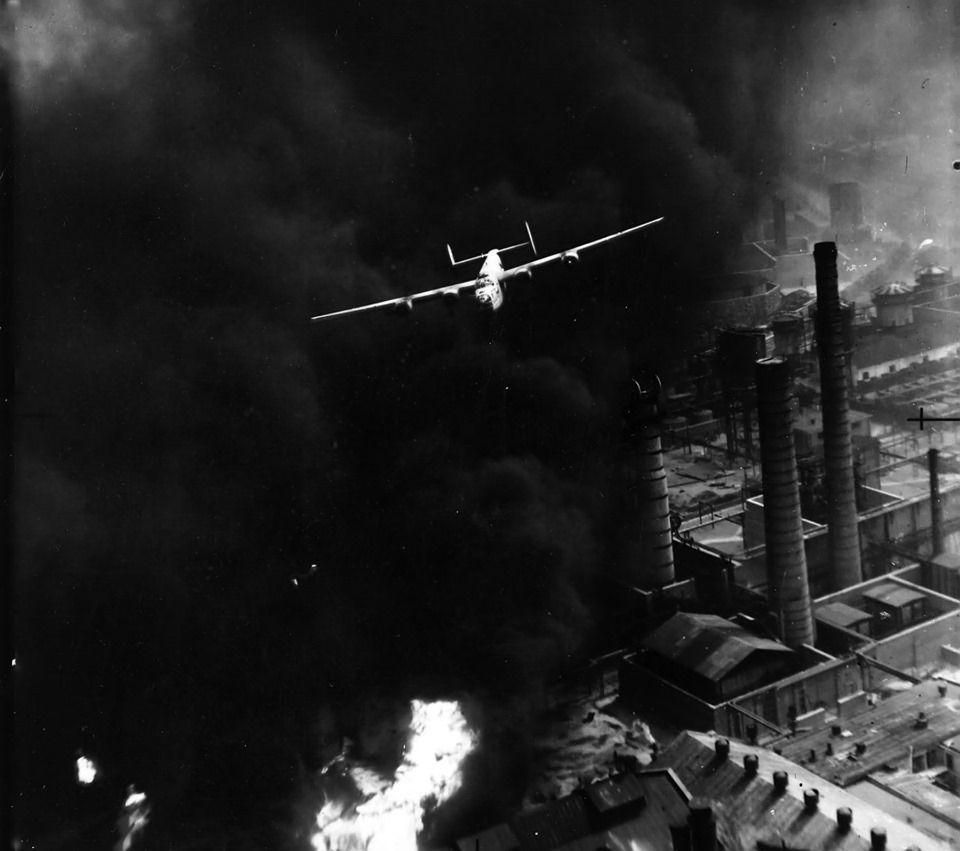
-
Awesome pics. Ha another Event Card for game. Remove 2 US bombers from Europe side of map. But totally huge sad losses.
-
@captainwalker Yes . Thoroughly enjoyed that.
What a terrible casualty rate. -
August 2, 1941. Eastern Front
Army Group North: German 16th Army (Colonel General Ernst Busch) continues attacking Staray Russa below Lake Ilmen.
Army Group Centre: General Guderian’s Panzer Group 2 attacks toward Roslavl as it heads south on Hitler’s express orders to help with the conquest of Kiev. The Soviet, meanwhile, ramp up their attacks on the advanced German “lightning rod” position at Yelnya.
Army Group South: After many days of very hard fighting, Panzer Group 1 (General Ewald von Kleist) completes the encirclement at Uman. This happens when German XLVIII Corps (General Kempf) hooks up with German 17th Field Army (General Carl-Heinrich von Stülpnagel). The closure southwest of Uman is all the more dangerous to the trapped Soviet forces because 16th Panzer Division and Hungarian Mechanised Corps (Gyorshadtest) also are close to forming a second, separate closure at Pervomaisk. The Soviets have parts of 20 divisions of their 6th, 12th, and 18th armies inside the pocket, including four corps commanders and 11 division commanders. Resistance does continue until about 8 August. However, except for small parties, the Soviets trapped today are unable to break out, and 103,000 Soviet soldiers go into captivity.

-
…oh the glory days!
-
75 Years Ago, Today: Saturday, August 5, 1944.
Photograph: The British recaptured what was left of Villers-Bocage on August 5, 1944. This view of a knocked-out Sherman tank and ruined buildings reveals the extent of the damage that two months of heavy bombing and fierce combat had wrought.
The General Staff of the German Armed Forces is informed by their generals in Normandy that Commonwealth forces are attacking south of Caen. Moreover, to the east of Avranches, in the Cotentin, the Americans continue their advance towards Mortain, south of Vire, defended by the 7th German army commanded by General Hausser. In Brittany, part of the 3rd Army of General Patton (two of the three corps of the 3rd Army) is now attacking towards the east, in the direction of Laval, Sainte-Suzanne and Mayenne.
The German troops between Thury-Harcourt and Mortain now fear an Anglo-Canadian encircling from the North and American from the South. The German headquarters decides to counter-attack massively and plans an operation that will begin in the coming days.
The British, aware of the bad German position between Mortain and Thury-Harcourt, decide to continue the BLUECOAT offensive for a time before concentrating their advance south of Caen to close the circle.
In Warsaw, Poland, the hopeless battle continues. The Polish forces liberate a concentration camp. But without the support promised by the Soviets, and then withheld, a German victory and terrible vengeance is only a matter of time.

-
Missed it by a few days, but: 75 years ago last week, my uncle, Bud Piper (a U.S. Army combat engineer), visited Paris…which wasn’t liberated until 24 AUG 44. His story, which I have no reason to doubt, is remarkable.
At the time, American engineer units were “free agents,” for lack of a better term - they would be temporarily attached to this brigade to build a bridge for them, then reassigned to that battalion to clear a path through a minefield for them, and so on. In between assignments, they had down time. My uncle compared it to firefighters at their station house, waiting for a call.
During one of these periods of down time, Bud said, word reached his unit that Paris had been liberated. They were only about 30 miles from the City of Light, so my uncle and a handful of his buddies hopped in a truck and headed down the road.
As Bud explained, “unlike WWI, the front line was riddled with gaps, and some of them were pretty large. We didn’t see any live Germans along the way.” Upon reaching Paris, they drove straight to the Eiffel Tower, parked the truck, got out and started taking pictures, like any other tourists. They got a few strange looks from the locals, Bud said, but they were used to strange looks from the French. While snapping photos, they saw a squad of Germans - still armed - marching a few hundred yards away. “We assumed they were marching off to surrender,” stated Bud.
One of Bud’s squad mates wanted to get his wife some “real Parisian lingerie,” so they set out to find a shop. “We didn’t speak French and couldn’t find anyone who would admit to speaking English, but we managed to find a lingerie shop nearby,” said Bud. “While we were inside, we saw another squad of Germans march right down the street, past the store. At that point, we figured the story about Paris being liberated was just a bullsh*t rumor and high-tailed it out of there. A week later, Paris was liberated for real.”
Hard to believe? Yes. Crazy enough to be true? Yes. My uncle has never been prone to embellishment, exaggeration, etc., so I have no choice but to accept it as true.
-
@The-Pripet-Martian An outstanding tale. My mother and I did an oral history project, “Guardians of Freedom” in 2000 and interviewed alot of these vets.
The Battle of the Bulge stories were similar to what you recollect; the captured American troops had no idea that German units were in the immediate vicinity, were basically confronted over their morning coffee and marched off into captivity. Complete surprise in a ‘rear’ area and they were not in prepared combat positions at all, they were in camp.
-
since it hasn’t been done yet
80 years since adolf attacked Poland
-
@barnee thanks . It is a day I never forget.
I reminded my 12 year old cousin’s son and he was flabbergasted to have forgotten. He is obsessed with WW2 and his dad (my younger cousin) has let him watch: Circle of Evil, which he loved. He did a project on WW2 and it was very good. We spoke at my parents’ 50th Anniversary and he was very knowledgeable.
It was a delight to see such passion in a school child.
I will tell my cousin to buy him 1942 fir Christmas. I am sure he will love it. -
The surrender of Japan on this day 1945
Also yesterday Germany started it all with the attack on Poland -
September 2, 1939. Poland
Using new tactics developed by Heinz Guderian, German forces advance 50 miles into Poland in 36 hours, threatening Krakow, Lodz and other cities.
The term BLITZKRIEG has not been coined yet. Large fast-moving group of tanks, tracked artillery and troop carriers (supported by dive bombers) penetrate the front lines and fan out deep in the enemy’s rear. They attack supply dumps and HQ companies unprepared for combat, while enemy front line units are isolated, surrounded and destroyed. The undermanned Polish army is not fully mobilized and equipped with ancient weapons and horse-drawn artillery. It is outmatched and quickly overwhelmed despite brave resistance.
Following earlier assurances of Poland’s security, France and Britain are committed to war with Germany but diplomatic and strategic questions delay an immediate response on this day. However, the evacuation of children from London begins.
Photo: Guderian (top right of photo in command vehicle) guides his Panzerwaffe in Poland.
